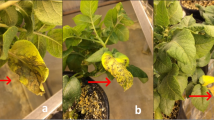Abstract
With continued expansion of Cucurbita pepo L. cultivation, viral diseases affecting the crop have become more serious in recent years, causing enormous losses in yield and quality. A virus sample was obtained from Wenshui in Shanxi province, China. Double-stranded RNA technology and sequence-independent amplification (SIA) were used to identify the virus that induced C. pepo L. mosaic disease. SIA and sequencing results showed the presence of watermelon mosaic virus (WMV) in diseased C. pepo L. leaves. The complete sequence of WMV from the Shanxi isolate (i.e., WMV-WS) was cloned and analyzed for further characterization. The genomic RNA of WMV-WS is 10,040 nucleotides in length and encodes a putative polyprotein of 3218 amino acids. Phylogenetic analysis indicate that all WMV isolates were divided into four groups and WMV-WS isolate belong to Group 4. Further analysis showed that these WMV isolates were not only to a certain degree related to the host, but also related to geographical origin of isolates. Our results provide information for a better understanding of the genetic diversity of WMV isolates infecting C. pepo L. in Shanxi, China.


Similar content being viewed by others
References
Agindotan B, Perry KL. Macroarray detection of plant RNA viruses using randomly primed and amplified complementary DNAs from infected plants. Phytopathology. 2007;97(1):119–27.
Aisan G, Nemat SB, Nahid M. Sequencing part of watermelon mosaic virus genome and phylogenetical comparison of 5 isolates with other isolates from world. J Agric Food Tech. 2012;2(6):93–101.
Chandrasekar B, Mukherjee B, Mukherjee SK. Blood sugar lowering potentiality of selected Cucurbitaceae plants of Indian origin. Indian J Med Res. 1989;90:300–5.
Clark MF, Adams AN. Characteristics of the microplate method of enzyme-linked immunosorbent assay for the detection of plant viruses. J Gen Virol. 1977;34(3):475.
Dodds JA, Morris TJ, Jordan RL. Plant viral double-stranded RNA. Phytopathology. 1984;22(22):151–68.
Elbeshehy EK, Metwali EM, Almaghrabi OA. Antiviral activity of Thuja orientalis extracts against watermelon mosaic virus (WMV) on Citrullus lanatus. Saudi J Biol Sci. 2015;22(2):211–9.
Fletcher JD, Wallace AR, Rogers BT. Potyviruses in New Zealand buttercup squash (Cucurbits maxima Duch.): yield and quality effects of ZYMV and WMV 2 virus infections. N Z J Crop Hortic Sci. 2000;28(1):17–26.
Huseini HF, Darvishzadeh F, Heshmat R, Jafariazar Z, Raza M, Larijani B. The clinical investigation of Citrullus colocynthis (L.) Schrad fruit in treatment of Type II diabetic patients: a randomized, double blind, placebo-controlled clinical trial. Phytother Res. 2009;23(8):1186–9.
Jain A, Singhai AK. Effect of Momordica dioica Roxb on gentamicin model of acute renal failure. Nat Prod Res. 2009;24(15):1379–89.
Lecoq H, Dafalla G, Desbiez C, Wipfscheibel C, Delecolle B, Lanina T, et al. Biological and molecular characterization of Moroccan watermelon mosaic virus and potyvirus isolate from eastern Sudan. Plant Dis. 2001;85(5):547–52.
Malboeuf CM, Yang X, Charlebois P, Qu J, Berlin AM, Casali M, et al. Complete viral RNA genome sequencing of ultra-low copy samples by sequence-independent amplification. Nucleic Acids Res. 2013;41(1):218–25.
Morris TJ, Dodds JA. Isolation and analysis of double-stranded RNA from virus-infected plant and fungal tissue. Phytopathology. 1979;69(8):854–8.
Niu YB, Yao M, Wang DF, Wang GJ, Gong Q. Identification of the pathogenic virus on Ailanthus altissima. Acta Phytopathol Sin. 2011;41(4):437–40.
Notomi T, Okayama H, Masubuchi H, Yonekawa T, Watanabe K, Amino N, et al. Loop-mediated isothermal amplification of DNA. Nucleic Acids Res. 2000;28(12):E63.
Nováková S, Flores-Ramírez G, Glasa M, Danchenko M, Fiala R, Skultety L. Partially resistant Cucurbita pepo showed late onset of the Zucchini yellow mosaic virus infection due to rapid activation of defense mechanisms as compared to susceptible cultivar. Front Plant Sci. 2015;6:263.
Purcifull DE, Hiebert E. Serological distinction of watermelon mosaic virus isolates. Phytopathology. 1979;69(2):112–6.
Rashidi AA, Mirhashemi SM, Taghizadeh M, Sarkhail P. Iranian medicinal plants for diabetes mellitus: a systematic review. Pak J Biol Sci. 2013;16(9):401–11.
Saiki RK, Gelfand DH, Stoffel S, Scharf SJ, Higuchi R, Horn GT, et al. Primer-directed enzymatic amplification of DNA with a thermostable DNA polymerase. Science. 1988;239(4839):487–91.
Stang A, Korn K, Wildner O, Uberla K. Characterization of virus isolates by particle-associated nucleic acid PCR. J Clin Microbiol. 2005;43(2):716–20.
Talukdar SN, Hossain MN. Phytochemical, phytotherapeutical and pharmacological study of Momordica dioica. Evid Based Complement Alternat Med. 2014;2014:806082.
Tzanetakis IE, Martin RR. A new method for extraction of double-stranded RNA from plants. J Virol Methods. 2008;149(1):167–70.
Tzanetakis IE, Keller KE, Martin RR. The use of reverse transcriptase for efficient first- and second-strand cDNA synthesis from single- and double-stranded RNA templates. J Virol Methods. 2005;124(1–2):73–7.
Ullman DE, Cho J, German L. Occurrence and distribution of cucurbit viruses in the Hawaiian Islands. Plant Dis. 1991;75(4):367–70.
Veronezi CM, Jorge N. Bioactive compounds in lipid fractions of pumpkin (Cucurbita sp) seeds for use in food. J Food Sci. 2012;77(6):653–7.
Vijayakumar M, Eswaran MB, Ojha SK, Rao C, Rawat AK. Antiulcer activity of hydroalchol extract of Momordica dioica roxb. Fruit. Indian J Pharm Sci. 2011;73(5):572–7.
Yasir M, Sultana B, Nigam PS, Owusuapenten R. Antioxidant and genoprotective activity of selected cucurbitaceae seed extracts and LC-ESIMS/MS identification of phenolic components. Food Chem. 2016;199:307–13.
Zhang XT, Wu ZJ, Lin QY, Xie LH. dsRNA isolation method and research of plant virology. J Yunnan Agric Univ. 2005;20(4):455–8.
Zhang JX, Yun-Feng WU, Wang R, Luo ZP. Complete nucleotide sequence of watermelon mosaic virus China isolate. Chin J Virol. 2007;23(2):153–6.
Zhao L, Feng C, Hao X, Sou M, Zhang J, Wang Q, et al. Complete genomic sequence analyses of watermelon mosaic virus isolates from China. J Plant Pathol. 2014;96(3):585–8.
Acknowledgements
This study was financially supported by grants from the special Fund for Agro-scientific Research in the Public Interest (Grant No. 201303028) and National Natural Science Foundation of China (Grant Nos. 31540050 and 31601612).
Author information
Authors and Affiliations
Corresponding author
Electronic supplementary material
Below is the link to the electronic supplementary material.
Rights and permissions
About this article
Cite this article
Niu, Y., Pang, X., Cheng, Y. et al. Molecular detection of watermelon mosaic virus associated with a serious mosaic disease on Cucurbita pepo L. in Shanxi, China. VirusDis. 28, 315–319 (2017). https://doi.org/10.1007/s13337-017-0388-2
Received:
Accepted:
Published:
Issue Date:
DOI: https://doi.org/10.1007/s13337-017-0388-2




